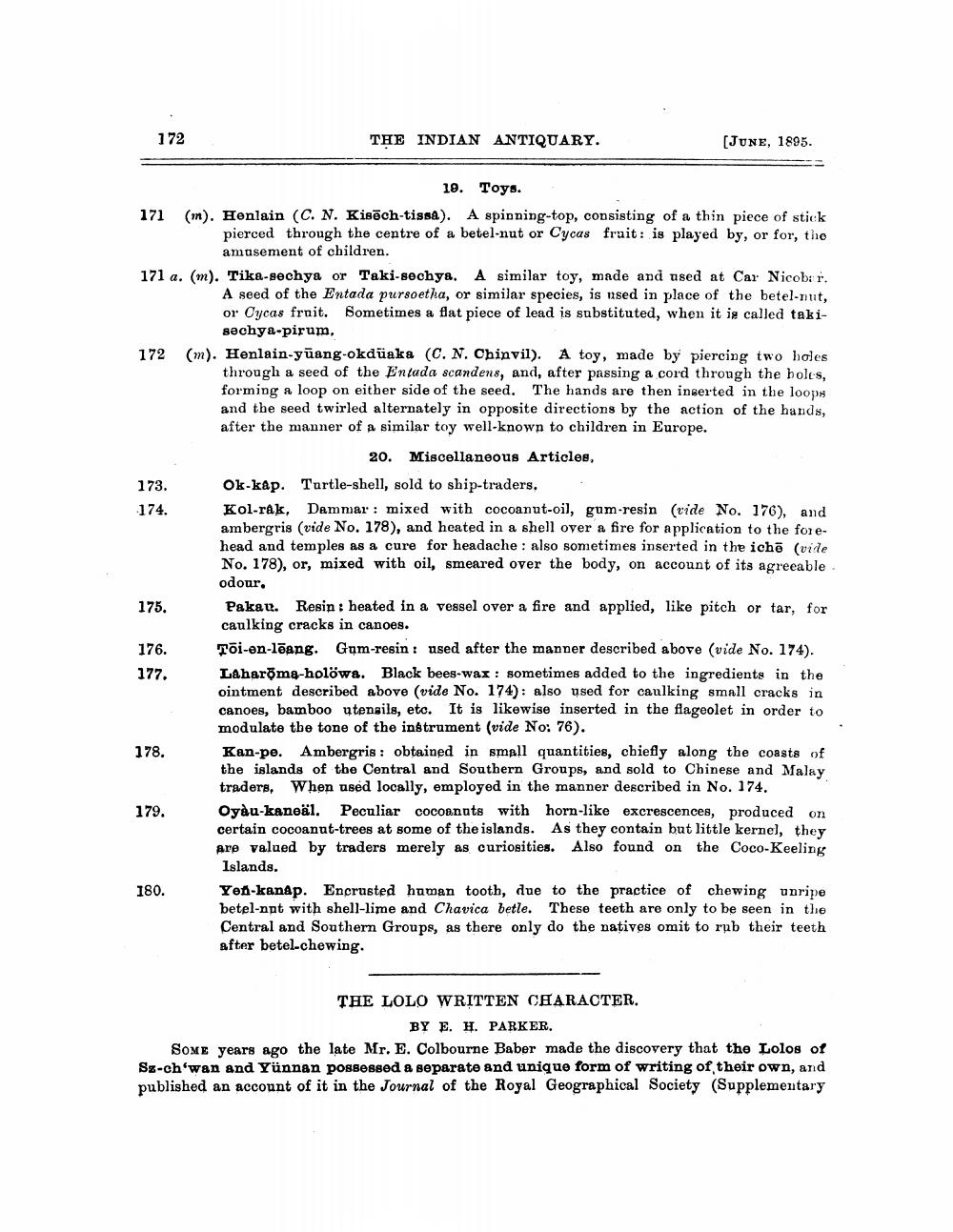________________
172
THE INDIAN ANTIQUARY.
(June, 1895.
173.
174
19. Toys. 171 (m). Henlain (C. N. Kis@ch-tissa). A spinning-top, consisting of a thin piece of stick
pierced through the centre of a betel-nut or Cycas fruit: is played by, or for, the
amusement of children. 171 a. (m). Tika-sochya or Taki-sechya. A similar toy, made and used at Car Nicobar.
A seed of the Entada pursoetha, or similar species, is used in place of the betel-nut, or Cycas fruit. Sometimes a flat piece of lead is substituted, when it is called taki
sochya-pirum, 172 m). Henlain-yuang-okdüaka (C. N. Chinvil). A toy, made by piercing two holes
through a seed of the Entada scandens, and, after passing a cord through the boles, forming a loop on either side of the seed. The hands are then inserted in the loops and the seed twirled alternately in opposite directions by the action of the hands, after the manner of a similar toy well-known to children in Europe.
20. Miscellaneous Articles, Ok-kap. Turtle-shell, sold to ship-traders. Kol-rak, Dammar: mixed with cocoanut-oil, gum-resin (vide No. 176), and ambergris (vide No. 178), and heated in a shell over a fire for application to the forehead and temples as a cure for headache: also sometimes inserted in the ichō (vide No. 178), or, mixed with oil, smeared over the body, on account of its agreeable odour,
Pakau. Resin : heated in a vessel over a fire and applied, like pitch or tar, for
caulking cracks in canoes. 176. Toi-en-loang. Gum-resin: used after the manner described above (vide No. 174). 177. Laharēmg-holowa. Black bees-wax: sometimes added to the ingredients in the
ointment described above (vide No. 174): also used for caulking small cracks in canoes, bamboo utensils, etc. It is likewise inserted in the flageolet in order to
modulate the tone of the instrument (vide No: 76). 178. Kan-pe. Ambergris : obtained in small quantities, chiefly along the coasts of
the islands of the Central and Southern Groups, and sold to Chinese and Malay
traders. When used locally, employed in the manner described in No. 174. 179. Oyàu-kaneäl. Peculiar cocoenats with horn-like excrescences, produced on
certain cocoanat-trees at some of the islands. As they contain but little kernel, they are valued by traders merely as curiosities. Also found on the Coco-Keeling
Islands. 180. Yen-kanap. Encrusted haman tooth, due to the practice of chewing unripe
betel-nat with shell-lime and Chavica betle. These teeth are only to be seen in the Central and Southern Groups, as there only do the natives omit to rub their teeth after betel-chewing.
175.
THE LOLO WRITTEN CHARACTER.
BY E. H. PARKER. SOME years ago the late Mr. E. Colbourne Baber made the discovery that the Lolos of Sg-ch'wan and Yunnan possessed a separate and unique form of writing of their own, and published an account of it in the Journal of the Royal Geographical Society (Supplementary




